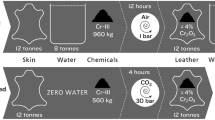Abstract
The suitability of a combined tanning system comprising zinc salts and an organic tanning agent as an alternative to chromium compounds was considered. The structure of the organic tanning agent synthesized on the basis of formaldehyde and ethanolamine was identified by IR spectroscopy. The effect of the zinc salts on the viscosity and pH of the tanning solution was evaluated. Different capacities of zinc acetate and zinc sulfate to interact with the organic tanning agent with formation of complexes were shown. The results obtained were confirmed by photometry. A probabilistic structural formula was proposed for the resulting complex. The conductometric method was employed to evaluate the change in the electrical conductivity of the aqueous solutions of zinc acetate and zinc sulfate in the presence of amino acids with various functional groups in the side chain. The effect of the salt anion on the ability to form complexes with different ligand coordination geometries of the central zinc atom as dependent on the type of amino acid was shown. The maximum yield of the complex was estimated basing on the deviation of the experimental dependence of the electrical conductivity from the calculated additive values at different amino acid to zinc salt ratios. A beneficial effect produced by gelatin pretreatment with the organic tanning agent on cellulose membrane sorption of the zinc salts from the aqueous solutions was revealed. It was shown that zinc sulfate was more intensively sorbed by gelatin after treatment with the organic tanning agent, and an interpretation to this effect was provided. The obtained data were validated in a real tanning process which demonstrated an increase in the hydrothermal stability of dermal collagen, achieved via sequential treatment with the organic tannin and zinc salts.






Similar content being viewed by others
REFERENCES
Morera, J.M., Bartolí, E., Chico, R., Solé, C., and Cabeza, L.F., J. Cleaner Prod., 2011, vol. 19, nos. 17–18, pp. 2128–2132. https://doi.org/10.1016/j.jclepro.2011.07.018
El-Khateeb, M.A., Nashy, E.-S.H., Ghany, N.A.A., and Awad, A.M., Desalin. Water Treat., 2017, vol. 65, no. 3, pp. 147–152. https://doi.org/10.5004/dwt.2017.20250
Badar, M., Saeed, M., and Batool, F., Int. J. Environ., Agric., Biotechnol., 2016, vol. 1, no. 3, pp. 559– 564. https://doi.org/10.22161/ijeab/1.3.38
Chursin, V.I., Tekhnologicheskie protsessy i ekologiya kozhevennogo proizvodstva (Technological Processes and Ecology of Leather Production), Moscow: Ross. Gos. Univ. im. A.N. Kosygina, 2019.
Panfilov, E.V. and Chursin, V.I., Izv. Vyssh. Uchebn. Zaved., Khim. Khim. Tekhnol., 2019, vol. 62, no. 9, pp. 110–116. https://doi.org/10.6060/ivkkt.20196209.5918
Mubark Yahia, Musa, A.E., Gasmelseed, G.A., Faki, E.F., Ibrahim, H.E., Haythem, O.A., Manal, M.A., and Haythem, S.B., Int. J. Adv. Ind. Eng., 2019, vol. 7, no. 2, pp. 104–110. https://doi.org/10.14741/ijaie/v.7.2.2
Chursin, V.I. and Chirkova, N.A., Izv. Vyssh. Uchebn. Zaved., Khim. Khim. Tekhnol., 2010, vol. 53, no. 1, pp. 91–93.
Saravanabhavan, S., Fashima, N.N., Rao, J.R., and Nair, B.U., J. Soc. Leather Technol. Chem., 2004, vol. 88, no. 2, pp. 76–81.
Magomedova, P.M. and Chursin, V.I., Abstracts of Papers, Materialy XIV mezhdunarodnoi nauchno-prakticheskoi konferentsii “Kozha i mekh v XXI veke: tekhnologiya, kachestvo, ekologiya, obrazovanie” (Proc. XIV Int. Sci. and Practical Conf. “Leather and Fur in XXI Century: Technology, Quality, Ecology, and Education”), Ulan-Ude: Vost.-Sib. Gos. Univ. Tekhnol. Upravl., 2018, pp. 18–26.
Cao, S., Cheng, B., Wang, Q., and Liu, B., J. Amer. Leather Chem. Ass., 2013, vol. 108, no. 11, pp. 428–433.
Parmar, A.S., Xu, F., Pike, D.H., Belure, S.V., Nida, F.H., Drzewiecki, K.E., Shreiber, D.I., and Nanda, V., Biochemistry, 2015, vol. 54, no. 32, p. 4987–4997. https://doi.org/10.1021/acs.biochem.5b00502
Kandile, N.G., Razek, T.M.A., Al-Sabagh, A.M., and Maamoun, M.T.K., Egypt. J. Petrol., 2014, vol. 23, no. 3, pp. 323–329. https://doi.org/10.1016/j.ejpe.2014.08.008
Krężel, A. and Maretb, W., Arch. Biochem. Biophys., 2016, vol. 611, no. 1, pp. 3–19. https://doi.org/10.1016/j.abb.2016.04.010
Ting, Y.-H., Chen, H.-J., Cheng, W.-J., and Horng, J.-Ch., Biomacromolecules, 2018, vol. 19, no. 7, pp. 2629–2637. https://doi.org/10.1021/acs.biomac.8b00247
Shachneva, E.Yu. and Zukhairaeva, A.S., Astrakh. Vestn. Ekol. Obraz., 2015, no. 2(32), pp. 122–124.
Pinto, D., Puppin, P.A.L., Behring, V.M., Alves, O.C., Rey, N.A., and Felcman, J., Inorg. Chim. Acta, 2012, vol. 386, no. 5, p. 60–67. https://doi.org/10.1016/j.ica.2012.01.025
Kadyrova, R.G., Kabirov, G.F., and Mullakhmetov, R.R., Biologicheskie svoistva i sintez kompleksnykh solei ɑ-aminokislot biogennykh metallov (Biological Properties and Synthesis of Complex Salts of α-Amino Acids of Biogenic Metals), Kazan: Kazan. Gos. Energ. Univ., 2014.
Yuan, S., Nawrocki, S., Stranick, M., Yang, Y., Zheng, C., Masters, J.G., and Pan, L., Inorg. Chem., 2016, vol. 55, no. 20, pp. 10094–10097. https://doi.org/10.1021/acs.inorgchem.6b01663
Jakubke, H.-D. and Jeschkeit, H., Aminosäuren, Peptide, Proteine, Weinheim: Chemie, 1982.
Sobel, S., Haigney, A., Concepcion, T., and Kim, M., Chemical Speciat. Bioavailab., 2008, vol. 20, no. 2, pp. 93–97 https://doi.org/10.3184/095422908X322833
Kochańczyk, T., Drozd, A., and Krężel, A., Metallomics, 2015, vol. 7, no. 2, pp. 244–257. https://doi.org/10.1039/C4MT00094C
Abdel-Mottaleb, M.S.A. and Ismail, E.H., J. Chem., 2019, vol. 23, no. 5, pp. 1–18. https://doi.org/10.1155/2019/3241061
Liu, D., Nikoo, M., Boran, G., Zhou, P., and Regenstein, J.M., Annu. Rev. Food Sci. Technol., 2015, vol. 6, pp. 527–557. https://doi.org/10.1146/annurev-food-031414-111800
Author information
Authors and Affiliations
Corresponding author
Ethics declarations
No conflict of interest was declared by the authors.
Rights and permissions
About this article
Cite this article
Chursin, V.I., Magomedova, P.M. Interactions in the Protein–Zinc Salt–Organic Tanning Agent System. Russ J Gen Chem 91, 2633–2639 (2021). https://doi.org/10.1134/S1070363221120355
Received:
Revised:
Accepted:
Published:
Issue Date:
DOI: https://doi.org/10.1134/S1070363221120355




